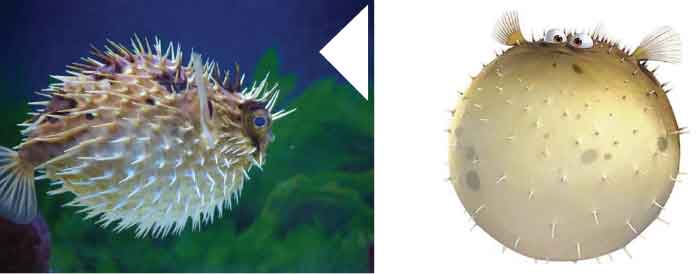

The spiny appendages cover most of its body, which may vary from light gray to tan, sometimes with dark spots. Its teeth are actually a fused beak-like structure. The Porcupine Puffer lacks pelvic fins but has learned to use the pectoral fins to move about. Porcupine fish are also commonly called blowfish and, sometimes, balloonfish and globefish.
Though Bloat’s character is sweet and kind, the Porcupine Fish (when placed in an actual aquarium) may express aggressiveness by nipping the fins of tank mates and will also eat certain invertebrates found in a reef aquarium. When threatened or scared, the porcupine fish can inflate its body to almost twice its normal size by swallowing air or water reducing the range of potential predators to those with much bigger mouths. A second defense mechanism is provided by the sharp spines, which radiate outwards when the fish is inflated.Parts of its flesh are also poisonous if digested, this poison is produced by several types of bacteria obtained from the fish's diet.
"Nemo, newcomer of orange and white, you have been called forth to the summit of Mt. Wannahockaloogie to join with us in the fraternal bonds of tankhood!"
The Porcupine Puffer has a varied diet of meaty foods including; squid, krill, clams, and hard shelled crustaceans to help wear down their ever growing teeth.
As a result of three defenses, porcupine fish have few predators, although adults are sometimes preyed upon by sharks and killer whales. Juveniles are also preyed on by tuna and dolphins. The porcupine fish is mentioned in Charles Darwin's famous account of his trip around the world The Voyage of the Beagle. He noted how the fish can swim quite well when inflated even though the altered buoyancy requires it to do so upside down.
Porcupinefish are commonly about 12 inches in length and usually have a lifespan of 5 years or longer. They are found in shallow temperate and tropical seas worldwide such as the Western Atlantic, Eastern Atlantic, South Africa, and the Red Sea.